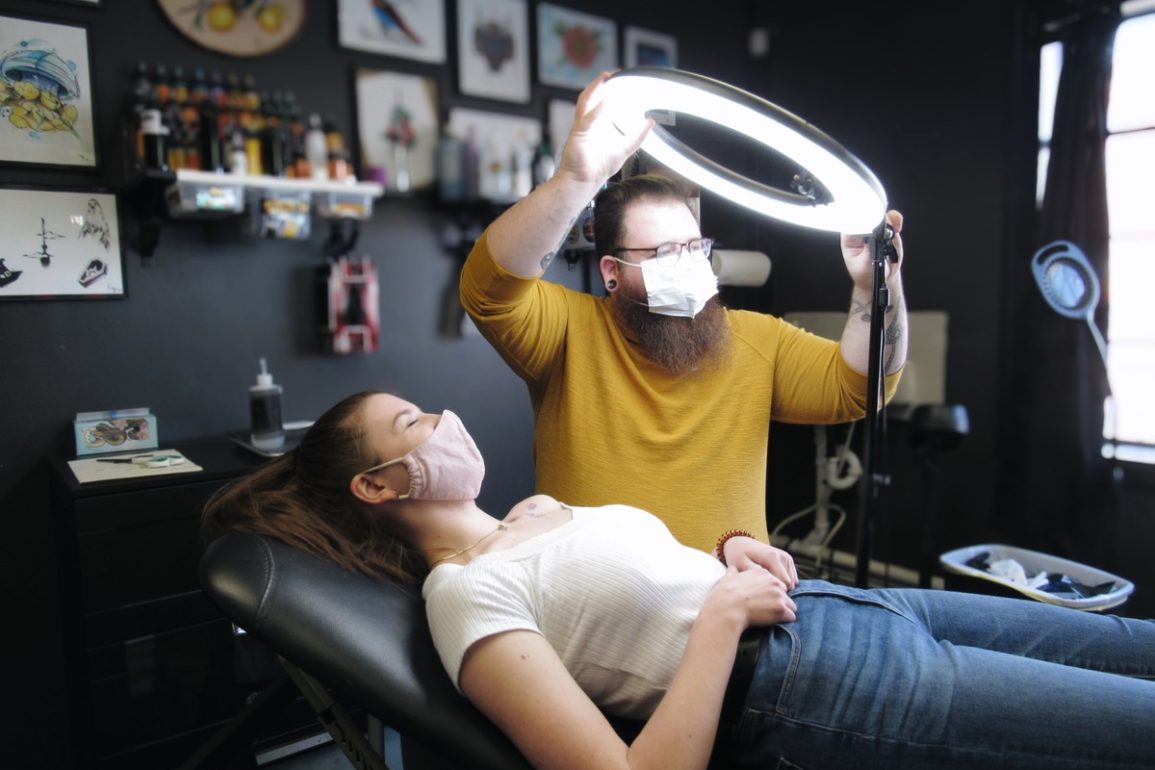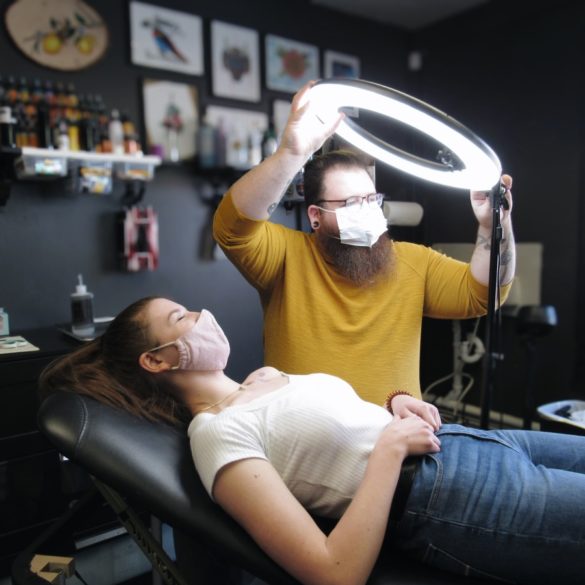Employees of Body Language Tattoo share their journeys to becoming tattoo and piercing technicians.
Right off of Ball State University’s campus sits a small strip of shops. When you scan the stores in this strip, commonly referred to by students as “The Village,” there are bookstores, bars, and pizza joints. But, above a café, lies a hidden gem: Body Language Tattoo. The shop, which opened in 2015, offers tattoos and body piercings.
Even with COVID-19 restrictions in place, the shop feels welcoming with vibrant music and artistic décor. The space is divided into sections, on the right are three units partitioned off for tattoo artists to have their own workspace, and across the room is a place for the sole body piercer.
Both Nikki Skowronek, the shop’s body piercer, and Cody Blackford, the lead tattoo artist, began their careers here.
Nikki and Cody came to Ball State without plans of becoming a tattoo artist or a piercing technician. Nikki has a bachelor’s degree in creative writing and French and Cody has a master’s degree in technology education. Both of them did their apprenticeships while they were finishing their degrees through Ball State after having gotten into the industry during their college years in Muncie.
During Nikki’s freshman year at Ball State, she came to Body Language Tattoo and got her first piercing in the very booth she now calls her own.
“All of my piercings except for my lobes have been done here… I’m like a walking advertisement for this place, but I’m not mad about it,” Nikki says about her collection of piercings and tattoos.
Cody also completed his internship through Body Language Tattoo while attending Ball State University.
“For a year there, I was actually doing 100-hour weeks or so because I was taking classes, teaching classes, doing research with a professor, and I was tattooing full time,” he says.
After surviving 2020, a year riddled with challenges due to the pandemic, Body Language Tattoo was able to thrive. Both sides of the business, tattooing and body piercing, were booked up once the shop reopened.
“People were itching to get in and get something done,” Nikki says.
Cody agrees that he has never seen the shop busier.
“I have no idea what made tattooing more popular. I wish I knew what it was so we could do more of it. I love that tattooing is popular…tattooing becoming more popular and accepted would be awesome,” he says.
According to a 2015 Harris Poll, in 2003 only 16% of all adults had a tattoo, whereas in 2015 it had increased to nearly 30%.
The want for tattoos are not the only part of the tattooing industry that is growing. Statistics calculated by IBISWorld show that the market size for the tattoo artist industry is predicted to grow 6.6% in the upcoming year, which exceeds the 3.1% average growth the industry has seen between 2016 to 2021.
This increase could be caused in part by the rise in acceptance of tattoos and elimination of the stigmas they once held. In the Harris Poll, when asked to compare those with tattoos to those without, 66% of adults voted that it made no difference to their perception of how respectable the individual is.
Assistant professor of counseling at Edinboro University Everett Painter says there’s also a stigma in tattoo research. According to Painter, early research into tattoos was presented as negative due to being centered around linking it to deviance.
“We’ve come from a place where it’s viewed even in research literature as something negative to where we are today where there is so much that is positive around tattoos,” says Painter.
Having grown up in a conservative household, Nikki has had to conquer her own fear of being perceived differently by those around her. Though she was willing to forfeit her nose piercings during pictures for her sister’s wedding, she has taken the stance that those around her must overcome their own prejudices when it comes to her freedom to express herself through piercings and tattoos.
“My grandma admitted to me last December that she liked all of my tattoos and piercings. So, it’s baby steps and might take a little bit. Don’t be discouraged. It’s your body,” she says.
According to a 2019 study conducted by Ipsos, three in 10 Americans have at least one tattoo, which is an increase of 9% since 2012.
Cody is concerned that sometimes those who come in to get tattoos do not always think about the permanence of it. He worries that, like types of fast fashion, people come in and get tattoos of what is trendy and cheap and do not realize that in a couple months’ time, it will no longer be relevant.
This exact concept may be why having illusion tattoos has made it to the runway on a few occasions. One being when Scott Campbell, a tattoo artist, was featured in the Louis Vuitton Spring 2011 menswear collection where he designed handbags and gave the models temporary tattoos to wear while on the runway.
“You want that tattoo to look as good as it can as long as you can. You want it to be something that’s going to be somewhat timeless,” says Cody.
To put it in perspective, Cody compares a tattoo to a shirt. Making a quick decision to buy a shirt that will last a few years should not weigh the same as deciding to get a tattoo that will last the rest of your life.
Quick decision tattoos are not the only ones people get, though. Painter says that there are a variety of reasons that individuals get tattoos such as coming-of-age to memorials and it all depends on the person.
“It’s an individual thing,” says Painter. “You have to talk to the individual to really discern what it is about [a tattoo] that appeals to them.”
Painter says that for individuals that have trauma that is directly related to the body, tattoos can be used to reclaim the body.
“It can be about revealing their inner selves to other people, but also controlling how and when they do that,” he says.
Cody advises to do lots of research before deciding on getting tattoos. Some artists have particular styles, and Cody cautions against asking an artist to stray from that. His top tips for getting tattooed include drinking plenty of water, finding references, and setting a budget.
“Some people get tattoos that mean a lot to them, some get things that they just think are cool, but they always act as reminders of where we are in life,” Cody says.






